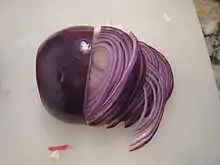Julienning
Julienne, allumette, or french cut, is a culinary knife cut in which the food item is cut into long thin strips, similar to matchsticks.[1] Common items to be julienned are carrots for carrots julienne, celery for céléris remoulade, or potatoes for Julienne Fries.


Trimming the ends of the vegetable and the edges to make four straight sides makes it easier to produce a uniform cut. Trimmings can be used for stocks, soups, purees, etc. The measurement for julienne is 1–2 mm × 1–2 mm × 4–5 cm (0.04–0.08 in × 0.04–0.08 in × 1.6–2 in). Julienne usually applies to vegetables prepared in this way but it can also be applied to the preparation of meat or fish, especially in stir fry techniques. Once julienned, turning the subject 90 degrees and dicing finely will produce brunoise (3 mm × 3 mm × 3 mm).
The first known use of the term in print is in François Massialot's Le Cuisinier Royal et Bourgeois (1722 edition).[1] The origin of the term is uncertain, but may derive from the proper name Jules or Julien. A potage julienne is composed of carrots, beets, leeks, celery, lettuce, sorrel, and chervil cut in strips a half-ligne in thickness and about eight or ten lignes in length. The onions are cut in half and sliced thinly to give curved sections, the lettuce and sorrel minced, in what a modern recipe would term en chiffonade.[2] The root vegetables are briefly sauteed, then all are simmered in stock and the julienne is ladled out over a slice of bread.
See also
References
| Wikimedia Commons has media related to Julienning. |
| Look up julienne in Wiktionary, the free dictionary. |
- Larousse Gastronomique. Hamlyn. 2000. p. 642. ISBN 0-600-60235-4.
- Viard, Alexandre (1820). Le Cuisinier Impérial (10th ed.). Paris. OCLC 504878002.